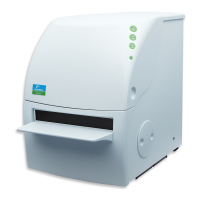Functional description
12
of the robot. The robot software communicates with the subsystem software.
Different kinds of robots can be used as the main system in an automated
HTS laboratory.
When used with a robot, EnVision is usually linked through COM
interfaces. These provide the basis for seamless integration and instrument
control. The robot and the counter work as a unit.
Optical system
The unique measurement performance of EnVision is a consequence of the
instrument's special optical design. The emission optical system features
Direct Double Optics. This means a full lens system without any light
guides or fiber bundles for measurements from above and a stray light
aperture between the two lenses. The latter configuration ensures optimized
use of a high quality interference filter and pure collection of emission light
from the excited sample volume.
The excitation optical system also employs two lenses. They are coupled
with a short length of quartz fiber bundle. The use of the fiber bundle allows
the optimal location of filter slides so that you can access them easily.
Another important advantage of using the fiber bundle is to ensure delivery
of a confined and stable circular spot into the sample volume.
Figure 4. Overall view of the optical components
In the pictures of the optical components, the two circles at the top represent
two light sources, the first light source (the larger circle) and the second
light source (the smaller circle), medium circles are path selectors, small
circles on top of slides represent filters. Rounded rectangles represent mirror
modules and pentagons are light detectors (PMTs and diode). All straight
lines represent direct optical paths using lens optics and all curved lines
represent optical paths using quartz light guides.
Note! With Ultra Sensitive Luminescence there is an additional detector, a
highly sensitive PMT. This is also used for HTS AlphaScreen.

